3. Naval Architecture. The Hellenistic Hull Design: Origin and Evolution
© Patrice Pomey, CC BY 4.0 https://doi.org/10.11647/OBP.0167.03
During the Hellenistic period and the Roman Republic, there was a dominant architectural design in Mediterranean naval architecture, which was eventually adopted by Greek and Roman shipyards as well as Punic. This system is characterised by a tripartite structure (keel, planking, framing). It allows the building of large ships with an elaborate hull shape, capable of good nautical performance, and this was clearly one of the factors behind the significant maritime expansion at the end of the first millennium BC. Of course, many other architectural approaches continued to be used in shipbuilding, which were testament to regional and local traditions.
The origin of this architectural system lies in the Greco-Roman evolution — between the second half of the sixth and the end of the fourth century BC — of sewn boats in the Greek tradition (influenced by the Phoenicians), which introduced the method of assembly by mortise and tenon. This resulted, throughout the Mediterranean, in a convergence of Greek and Phoenico-Punic architectural systems. However, during the Roman Empire, this approach — which presents a structural weakness at the level of the keel — was replaced by a new architectural type, apparently more robust, characterized by a flat bottom section, overlapping frames, and a keelson/mast step timber fitted on lateral sister-keelson.
Nevertheless, the Hellenistic architectural system endured in the Eastern Mediterranean until at least the Early Byzantine period, as evidenced by the wreck of Yassiada 1.
In ancient naval architecture, the Hellenistic period is exceptional. It saw tremendous expansion in the field of shipbuilding, since the technical progress made over the previous centuries made it possible to build larger ships and more advanced hull shapes. Thus, the technical characteristics of the vessels were greatly improved in both terms of tonnage and sailing performance.1
Historical events helped to foster these developments and played a dynamic role in their evolution. The rivalries between the Hellenistic kingdoms, fuelled by the Alexandrian Empire, quickly led to an arms race, which resulted in the building of more and more large war galleys. From the trireme of the Classical period with its three rows of oars followed the quadrireme and the quinquereme, then the super-galleys of six and more. Appearing at the end of the fourth century BC in the fleet of Demetrios Poliorcetes, these super-galleys expanded quickly to reach the level of twenty and thirty rows of oars and culminate, towards the end of the third century BC, with the forty of Ptolemy IV Philopator powered by 4000 rowers.2 Although the Romans were then confined to building quinqueremes, they built fleets of at least 100 and 200 units during the first Punic War.3 Merchant vessels did not escape this phenomenon of gigantism and, in the third century BC, Hiero II of Syracuse, who wished to show the power of his country’s shipyards and the richness of their local wheat fields, built the Syracusia, the largest grain ship of its time.4 This was a ship purpose-built for trade but heavily armed, with three masts and three bridges, and with a crew of more than 825 people; its tonnage is estimated at 2000 to 4000 tonnes. Regardless of the method of calculation, this tonnage is huge and the launch of the ship required the assistance of Archimedes. But this technical exploit remained short-lived; the largest ships of the time in common use belong to the class of myriophoroi, carrying 10,000 amphorae, or 500 tonnes of deadweight.5 These giant ships were exceptional, but their architecture remains largely unknown. Nonetheless, their existence reveals the technical capacity of large shipyards of the time.
However, thanks to a number of particularly representative wrecks, we can form an idea of the dominant architectural system in use in the Greek, Roman and Punic shipyards during the Hellenistic and Roman Republic. This system is based on a tripartite structure, used to construct ancient Mediterranean ships since at least the Archaic period. This structure is composed of an axial frame (keel, stem, sternpost), planking and transverse framing (frames, beams). Within this structure, the various elements can be given a number that define a particular architectural type, one we can call ‘Hellenistic’. Among these features, some are common to all Hellenistic ships. They are said to be ‘major’ or ‘primary’. Others, however, can be variable and are called ‘secondary’.
The major characteristics are:
- a cross-section with a retour de galbord, i.e. a cross-section with a wine-glass profile;
- an axial frame, composed of a keel extended toward the extremities by the stem and sternpost; according to the ship’s importance, end pieces can be more or less numerous and form stem and stern complexes;
- a rabbeted keel and a carved polygonal garboard;
- a carvel planking assembled by mortise-and-tenon joints;
- a framing system composed of alternating floor timbers and half frames faced on the keel axis; floor timbers and half frames are extended by futtocks fitted with butt joint; all the frames elements are nailed or tree-nailed to the planking; the floor timbers, with some exceptions, are independent of the keel;
- transverse beams supported by the wales of the planking;
- an internal axial frame with a keelson/mast-step timber extended by a simple keelson; keelson and mast-step timber are fitted on the back of the floor timbers;
- a longitudinal internal framing composed of stringers nailed to the frames and mobile ceiling planks.
The secondary characteristics are:
- a longitudinal section which may include an important rake; the bow shape (convex, straight or concave) varies according to the vessel type;
- the stem complex may include a cutwater, and the stern complex a heel located under the sternpost in the extension of the keel, and acting like a drift board;
- the planking might be single- or double-covered with lead sheathing.
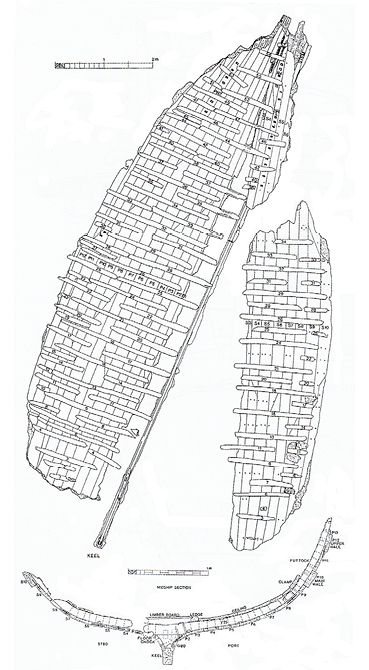
Figure 3.1 Kyrenia shipwreck. Plan and amidship cross-section (Steffy 1994).
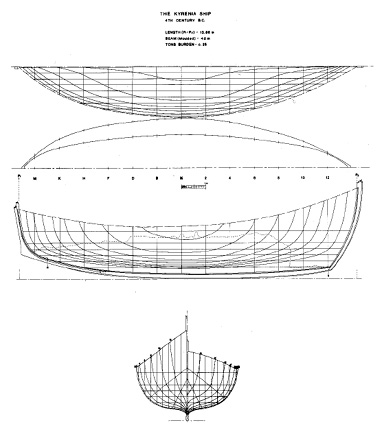
Figure 3.2 Kyrenia shipwreck. Reconstructed hull lines (Steffy 1994).
The first known example of this architectural type is the Kyrenia wreck, which is dated to the beginning of the third century BC, c. 295–285.6 The shell, however, shows evidence of a number of repairs that indicate the boat enjoyed many seaworthy years before it sank. Therefore, it is possible to date its construction to c. 325–315 BC, and to hypothesise that it was therefore during this century that this architectural type was developed. The Kyrenia ship has the main features of the Hellenistic type, including the wine-glass cross-section, the planking assembled by tenon-and-mortise joints, alternate frames and the mast-step timber fitted on the back of the floor timbers (see figs. 3.1 and 3.2). It should be noted that the frames are fixed to the planking by means of clenched nails driven into wooden dowels, and lead sheathing has been set in afterwards to strengthen the hull and to complete its waterproofing. If it is not unique, the lead sheathing of the Kyrenia wreck is the first known example of this type of protection. In the following century, lead sheathing is mentioned on the Syracusia where it was set from the beginning of the construction, before the ship launched. It is also documented on the Punic wreck near Marsala (mid-third century BC) (Fig. 3.3).7

Figure 3.3 Marsala shipwreck. Hull plan (Frost 1976).
This last wreck has all the main features of the Hellenistic type, and it reflects the unification of architectural systems across the Mediterranean, from the Greco-Roman world to the Punic world. Nevertheless, within this architectural type, it is possible to find many variations depending on the secondary characteristics. The Roman ship dating from the first century BC (c. 75–60 BC), found wrecked in 1967 off Madrague de Giens on the Giens peninsula, illustrates the high degree of sophistication attained by this type (of which it is likely to be one of the best examples) (Fig. 3.4).8
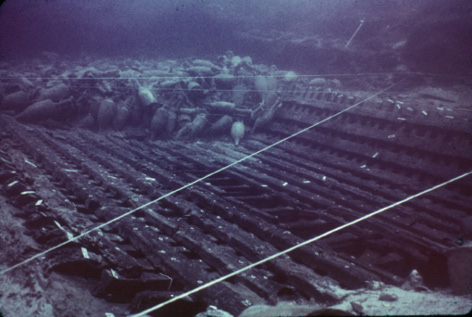
Figure 3.4 Madrague de Giens shipwreck. General view of hull (Photo A. Chéné, AMU, CNRS, MCC, CCJ).
According to its dimensions, nearly 40 m long, 9 m wide and 4.50 m deep, and its tonnage, estimated to be 400 tonnes deadweight, 9 the ship belongs to the category of myriophoroi (Figs. 3.5 and 3.6).10

Figure 3.5 Madrague de Giens shipwreck. Plan of the hull remains (Drawing M. Rival, AMU, CNRS, MCC, CCJ).
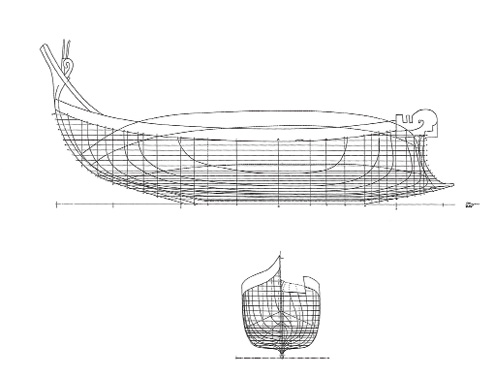
Figure 3.6 Madrague de Giens shipwreck. Reconstructed hull lines (Drawing M. Rival, AMU, CNRS, MCC, CCJ).
Its structure, characteristic of the Hellenistic type, is distinguished by its elaborate forms, its stem and stern complex and its double planking reinforced by lead sheathing (figs. 3.7, 3.8, 3.9 and 3.10).

Figure 3.7 Madrague de Giens shipwreck. Amidship cross-sections (Drawing J.-M. Gassend, M. Rival, AMU, CNRS, MCC, CCJ).

Figure 3.8 Madrague de Giens shipwreck. General axonometric view (Drawing J.-M. Gassend, M. Rival, AMU, CNRS, MCC, CCJ).

Figure 3.9 Madrague de Giens shipwreck. Axial axonometric view (Drawing J.-M. Gassend, M. Rival, AMU, CNRS, MCC, CCJ).

Figure 3.10 Madrague de Giens shipwreck. Axonometric view of the keel, the double planking and the hull sheathing (Drawing J.-M. Gassend, M. Rival, AMU, CNRS, MCC, CCJ).
The stern complex includes no fewer than six frame pieces, buttressed one by the other, in order to give structural rigidity to the long rake aft. Among these pieces a stern heel, located under the sternpost and in the extension of the keel, acts as a drift spoiler (Fig. 3.11).

Figure 3.11 Madrague de Giens shipwreck. Axonometric views of the stem complex (top) and the stern complex (bottom) (Drawing M. Rival, AMU, CNRS, MCC, CCJ).
As for the stem complex, located in the extension of a long raised forefoot, it has an inverted (convex) stem extended on the front by a cutwater. The whole, formed by the prominent keel, the drift spoiler and the cutwater, forms a very important drift plan, which was to make the ship very stable at all sailing trims (Fig. 3.12). Finally, it should be noted that a number of floor timbers are attached to the keel by a strong copper bolt (Fig. 3.13). This is the oldest known example of the use of such bolts that has been discovered, although they are described as being used in the earlier Syracusia. However, the floor timbers of the Madrague de Giens wreck, including the bolted ones, do not touch the keel, and remain largely independent. The few bolts therefore appear to be reinforcing the keel/floor-timber link to remedy the structural weakness of the longitudinal axis, due to the prominence of the keel and the independence of the floor timbers.11 In fact, the examination of these bolted floor timbers shows that they were not pre-erected, and so they do not call into question the longitudinal conception and the shell construction principle of the ship.12
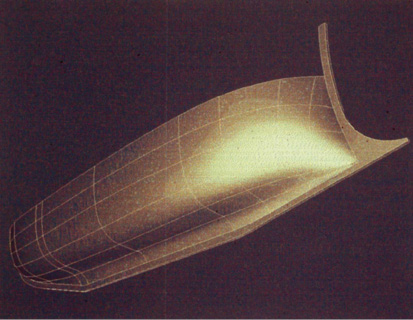
Figure 3.12 Madrague de Giens shipwreck. 3D reconstruction of the hull shapes (Drawing Sistre international).

Figure 3.13 Madrague de Giens shipwreck. Detailed section of the keel area. Note the bolt joining the floor-timber to the keel (Drawing J.-M. Gassend, M. Rival, AMU, CNRS, MCC, CCJ).
As to the construction process, everything indicates that the ship was probably built using a ‘shell first’ method.
If questions arise about the wreck of Madrague de Giens because of the presence of bolted floor timbers, it is clear that the Kyrenia wreck was entirely conceived and realized ‘shell first’, as was the Marsala wreck.13 As a result, everything indicates that the Hellenistic type of vessel was conceived according to the principle of the longitudinal and ‘shell’ construction and built according to the ‘shell first’ process.
As we can see, this dominant architectural system allowed for the building of ships of large size with an elaborate hull shape, capable of good nautical performance. The system also seems well adapted to the construction of coasters (Kyrenia) as well as oceangoing vessels (Madrague de Giens) or warships (Marsala). It was adopted for use in both private and state shipyards. In addition to the wrecks previously discussed, the Hellenistic type can be identified with its variants on the following wrecks: Baie de Briande (first half of the second century BC), Grand Congloué (second century BC), Caveaux I (end of the second — beginning of the first century BC), Cavalière (c. 100 BC), Mahdia (beginning of the first century BC), Albenga (first half of the first century BC), Pointe de Pomègues (first half of the first century BC), Chrétienne A (c. 75 BC), Dramont A (mid-first century BC), Titan (mid-first century BC), Plane I (mid-first century BC) (Fig. 3.14).

Figure 3.14 Dramont A shipwreck. Axonometric view of the central part of the hull (Drawing Cl. Santamaria).
This architectural system is clearly one of the factors that led to the significant maritime expansion of the end of the first millennium BC. Of course, this type, although dominant, did not preclude the existence of many other architectural types that attest to regional and local traditions.
The origin of this architectural system lies in the Greco-Roman evolution — between the second half of the sixth and the end of the fourth century BC — of sewn boats in the Greek tradition.14 According to the most ancient archaeological examples we have — including the shipwrecks of Giglio, Pabuc Burnu, Cala Sant Vicenç, Bon-Porté 1 and Jules-Verne 9, all dating back to the sixth century BC15 — ancient Greek ships were entirely assembled by ligatures (figs. 3.15, 3.16 and 3.17).

Figure 3.15 Jules-Verne 9 shipwreck. General view of the hull remains (Photo M. Derain, AMU, CNRS, MCC, CCJ).
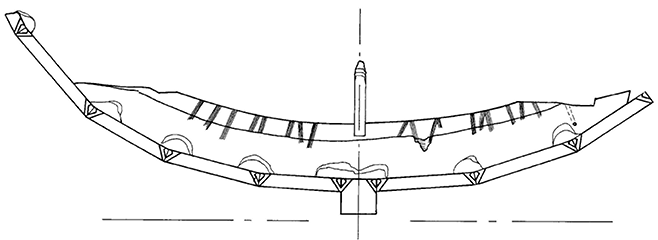
Figure 3.16 Jules-Verne 9 shipwreck. Cross-section of the hull remains (Drawing M. Rival, AMU, CNRS, MCC, CCJ).
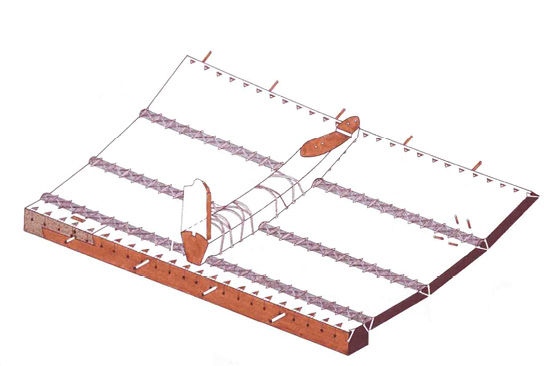
Figure 3.17 Jules-Verne 9 shipwreck. Axonometric view of the sewing and lashing of the hull assembly system (Drawing M. Rival, AMU, CNRS,MCC, CCJ).
During the first transitionary phase, illustrated by the shipwrecks Jules-Verne 7, Villeneuve-Bargemon 1 (or Caesar 1), Grand Ribaud F and Gela 1, the assembly systems by tenon-and-mortise joint for the planking and by nailing for the frames emerges (Figs. 3.18, 3.19, 3.20, 3.21 and 3.22).

Figure 3.18 Jules-Verne 7 shipwreck. General view of the hull remains (Photo M. Derain, AMU, CNRS, MCC, CCJ).

Figure 3.19 Jules-Verne 7 shipwreck. Amidship cross-section of the hull remains (Drawing M. Rival, AMU, CNRS, MCC, CCJ).

Figure 3.20 Theoretical schema of the mortise-and-tenon joint (Drawing M. Rival, AMU, CNRS, MCC, CCJ).

Figure 3.21 Jules-Verne 7 shipwreck. Schema of the mortise-and-tenon joint network (Drawing M. Rival, AMU, CNRS, MCC, CCJ).
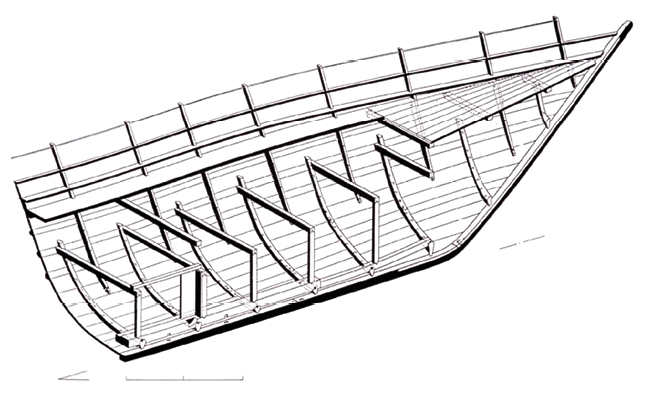
Figure 3.22 Jules-Verne 7 shipwreck. General axonometric view of the hull structure (towards the bow). Note the framing with floor-timbers alternating with top timbers; the mast step timber fitted on the floor-timbers; the beams fitted on the extremities of the floor-timbers (Drawing M. Rival, AMU, CNRS, MCC, CCJ).
They come as a substitute for the previous sewing and ligatures. However, the sewing did not disappear completely and was still used for some parts of the ship, mainly at first for the extremities, and then for repairs. In the second phase of the development of the Hellenistic type, defined by the shipwrecks Gela 2 and Ma’agan Mikhael, the use of sewing becomes even less common in favour of the development of the tenon-and-mortise joint. The hull shapes begin to evolve and the hull bottom, previously round, starts to present a wine-glass cross-section (Figs. 3.23, 3.24 and 3.25). Finally, the last stage of development is provided by the Kyrenia wreck: the seams and ligatures have totally disappeared, except in some reused planks; the hull cross-section is now a wine-glass shape and the keel is completely rabbeted. The frames, originally trapezoidal in order to be strongly lashed, are rectangular and nailed to the planking; while the top timbers, located between the floor timbers and formerly implanted only in the top of the wall, are extended to the hull bottom in order to form half frames faced on the keel axis.

Figure 3.23 Ma’agan Mikhael shipwreck. Plan and longitudinal section of the hull remains (Kahanov, Linder 2004).
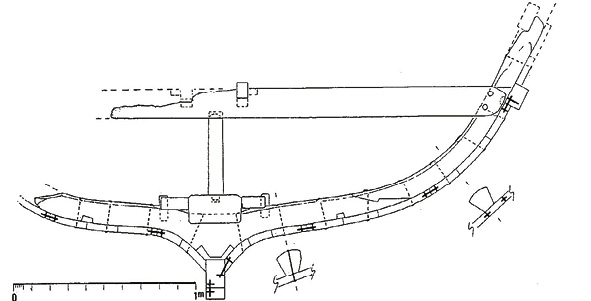
Figure 3.24 Ma’agan Mikhael shipwreck. Main cross-section of the hull remains (From Kahanov, Linder 2004).

Figure 3.25 Ma’agan Mikhael shipwreck. Top view of the bow with the sewn bow knee (Kahanov, Linder 2004).
The mast-step timber, since the earliest evidence of Greek sewn boats of the sixth century BCE and according to the example provided by the Bon-Porté wreck, was directly fitted on the back of the floor timbers. Thus, the Kyrenia wreck, which is located at the end of the chain of evolution of Greek shipbuilding, already has the main characteristics that define the Hellenistic type, and represents the prototype.
It is obvious that the replacement of the sewing of the planking by tenon-and-mortise joints and of the ligatures of the framing by nails or treenails contributed significantly to enhance the strength of the hulls and their longevity. This evolution led to the building of larger ships with a greater tonnage, and with significantly evolved hull shapes, which enabled the development of new ship types like the trireme (Fig. 3.26).16 As to the origin of this evolution, which led to the introduction of the tenon-and-mortise joint in the Greek tradition, it appears more likely that it is a Punic influence, where this system had been in use since the Bronze Age,17 rather than an internal evolution.18 That explains the convergence across the entire Mediterranean of Greek and Phoenico-Punic traditions, leading to the Hellenistic type that was used in the Greco-Roman and Punic worlds.

Figure 3.26 Trireme replica Olympias. General plans (J.F. Coates).
However, if the Hellenistic type offers some undeniable sailing qualities, as seen through the Madrague de Giens vessel, it presents nevertheless a structural weakness at the keel level. This weakness is due to the prominence of the keel, characteristic of the wine-glass cross-section, and to the lack of connection between the keel and the floor timbers. Many shipwrecks (Pointe de Pomègues, Plane I, Caveaux I, Baie de Briande, Chrétienne A, to name only those found off French coasts), which sank after losing their keel following a shock, testify eloquently to this problem (Fig. 3.27).


Figure 3.27 a- Baie de Briande shipwreck; b- Chrétienne A shipwreck. Note the rupture or the loss of the keel (Drawing M. Rival, AMU, CNRS, MCC, CCJ).
We have seen, in the case of the Madrague de Giens wreck, that this is most likely what led to the development of the practice of bolting the floor timbers.19 This practice probably prefigured the use of pre-built active frames that marked the beginning of the evolution towards a skeleton construction.20 But it is perhaps also the reason for the advent under the Roman Empire of a new architectural type of ship, with flat floor timbers, which mainly originated in the Western Mediterranean, and for this reason was called the Western Imperial Roman type.21 With a relatively flat bottom without prominent keel, internal framing strengthened with numerous floor timbers bolted to the keel, overlapping half frames and a mast-step timber fitted on two sister keelson, this ship type, with a large loading capacity, should have been structurally stronger, although not necessarily better in terms of its qualities for sailing (Fig. 3.28). It is probably due to these nautical qualities that the Hellenistic type did not become extinct within the time of the Mediterranean trade fleets, surviving in the Eastern Mediterranean until the Byzantine period, as shown in the wrecks of Yassiada 2 (fourth century AD),22 Yassiada 1 (seventh century AD)23 and Bozburun (ninth century AD)24 (Figs. 3.29, 3.30 and 3.31).

Figure 3.28 Western Roman Imperial type: top- Laurons 2 shipwreck; bottom- La Bourse shipwreck (Marseilles) (P. Pomey, AMU, CNRS, MCC, CCJ).
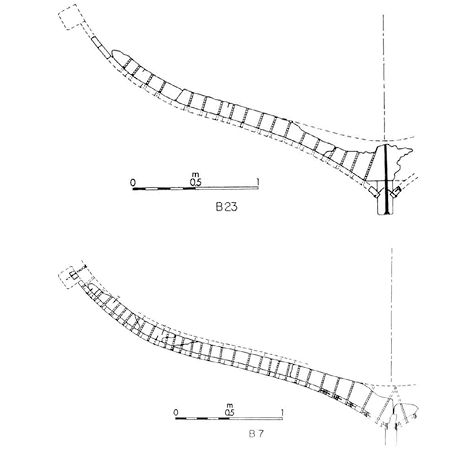
Figure 3.29 Yassiada 2 shipwreck. Cross-sections at frame B7 and B23 (van Doorninck 1976).

Figure 3.30 Yassiada 1 shipwreck. Amidship cross-sections (Steffy 1982).

Figure 3.31 Bozborum shipwreck. Cross-section of the hull (floor-timber 1) (Harpster 2002).
Similarly, in Roman nautical iconography, including in Africa, the Hellenistic type is always represented, as can be seen on the mosaic of the Syllectani in the Piazzale delle Corporazioni in Ostia Antica (end of the second century AD), and on the mosaic of the frigidarium of the baths of Themetra (Tunisia, third century AD), whose large vessels represent similar ships to the Madrague de Giens25 (Figs. 3.32, 3.33 and 3.34).

Figure 3.32 Mosaic of the frigidarium of the bath of Themetra (Tunisia, 3rd c. AD). Ship of Madrague de Giens type (Photo R. Guéry, AMU, CNRS, MCC, CCJ).
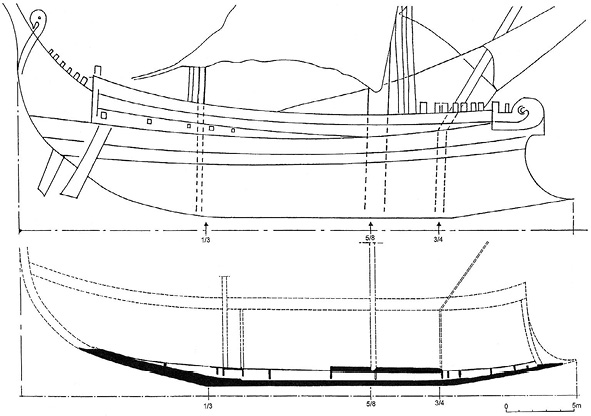
Figure 3.33 Comparative sketch of the Themetra ship (top) and the Madrague de Giens (below). Note the similarity of the hull profiles (Drawing M. Rival, AMU, CNRS, MCC, CCJ).

Figure 3.34 Mosaic of the Syllectani in the Piazzale delle Corporazioni (Ostia Antica, late 2nd c. AD). Note the similarity of profile between the ship on the left and the Madrague de Giens (Photo A. Chéné, AMU, CNRS, MCC, CCJ).
Bibliography
Basch, L. 1987. Le musée imaginaire de la marine antique. Athens: Institut hellénique pour la préservation de la tradition nautique.
Bass, G. F., and F. H. Jr. van Doorninck, eds. 1982. Yassi Ada Volume 1. A Seventh-Century Byzantine Shipwreck. College Station: Texas A&M University Press.
Casson, L. 1971. Ships and Seamanship in the Ancient World. 2nd ed. Princeton: Princeton University Press.
Frost, H. 1976. Lilybaeum (Marsala). The Punic Ship: Final Excavation Report. Notizie degli Scavi di Antiquità Suppl. 30. Rome: Accademia nazionale dei Lincei.
Harpster, M. 2009. ‘Designing the 9th-Century-AD Vessel from Bozburun.’ International Journal of Nautical Archaeology and Underwater Exploration 38: 297–313. https://doi.org/10.1111/j.1095-9270.2009.00226.x
Kahanov, Y., and E. Linder. 2004. The Ma’agan Mikhael Ship. The Recovery of a 2400-Years-Old Merchantman. Vol. 2. Final Report. Haifa: Israel Exploration Society.
Kahanov, Y., and P., Pomey. 2004. ‘The Greek Sewn Shipbuilding Tradition and the Ma’agan Mikhael Ship: A Comparison with Mediterranean Parallels from the Sixth to the Fourth Centuries BC.’ The Mariner’s Mirror 90: 6–28. https://doi.org/10.1080/00253359.2004.10656882
Nantet, E. 2016. Phortia. Le Tonnage des navires de commerce en Méditerranée du VIIIe siècle av. l’ère chrétienne au VIe siècle de l’ère chrétienne. Rennes: Presses Universitaires de Rennes.
Liou, B., and P. Pomey. 1985. ‘Informations archéologiques: recherches sous-marines.’ Gallia 43: 547–76.
Polzer, M. E. 2010. ‘The VIth-Century B.C. Shipwreck at Pabuç Burnu, Turkey: Evidence for Transition from Lacing to Mortise-and-Tenon Joinery in Late Archaic Greek Shipbuilding.’ In Transferts technologiques en architecture navale méditerranéenne de l’Antiquité aux temps modernes: identité technique et identité culturelle, Actes de la Table Ronde, Istanbul 2007, edited by P. Pomey: 27–44. Varia Anatolica 20. Istanbul: Institut français d’études anatoliennes-Georges-Dumézil.
Polzer, M. E. 2011. ‘Early Shipbuilding in the Eastern Mediterranean.’ In The Oxford Handbook of Maritime Archaeology, edited by A. Catsambis, B. Ford, and D. Hamilton, 349–78. New York: Oxford University Press. https://doi.org/10.1093/oxfordhb/9780199336005.013.0016
Pomey, P. 1982. ’Le navire romain de la Madrague de Giens.’ Comptes-Rendus de l’Académie des Inscriptions et Belles: CRAI 126(1): 133–54.
Pomey, P. 1988. ‘Principes et méthodes de construction en architecture navale antique.’ In Navires et commerces de la Méditerranée antique, Hommage à Jean Rougé. Cahiers d’Histoire 33: 397–412.
Pomey, P. 1998. ‘Conception et réalisation des navires dans l’Antiquité méditerranéenne.’ In Concevoir et construire les navires. De la trière au picoteux, edited by E. Rieth, 49–72. Technologie, Idéologies, Pratique, Revue d’anthropologie des connaissances. Ramonville-Sainte-Agne: Erès.
Pomey, P. 1997. ‘Un exemple d’évolution des techniques de construction navale antique: de l’assemblage par ligatures à l’assemblage par tenons et mortaises.’ In Techniques et économie antiques et médiévales, ‘Le temps de l’innovation’, Colloque international, Aix-en-Provence 1996, edited by D. Garcia and D. Meeks, 195–203. Paris: Errance.
Pomey, P. 2002. ’Remarque sur la faiblesse des quilles des navires antiques à retour de galbord.’ In Vivre, produire et échanger: reflets méditerranéens. Mélanges offerts à B. Liou, edited by L. Rivet and M. Sciallano, 11–19. Montagnac: Monique Mergoil.
Pomey, P. 2004a. ‘Principles and Methods of Construction in Ancient Naval Architecture.’ In The Philosophy of Shipbuilding. Conceptual Approaches to the Study of Wooden Ships, edited by F. M. Hocker and C. A. Ward, 25–36. College Station: Texas A&M University Press.
Pomey, P. 2004b. ‘La structure du navire de la Madrague de Giens et le type hellénistique.’ Ligures, Rivista di Archeologia, Storia, Arte e Cultura Ligure 2: 370–73.
Pomey, P. 2009. ‘Sur les eaux d’Alexandrie: des navires et des bateaux.’ In Du Nil à Alexandrie. Histoire d’eaux, edited by I. Hairy, 514–35. Alexandria: Harpocrates.
Pomey, P. 2011. ‘Les conséquences de l’évolution des techniques de construction navale sur l’économie maritime: quelques exemples.’ In Maritime Technology in the Ancient Economy: Ship-Design and Navigation, edited by W. V. Harris and K. Iara, 39–55. Journal of Roman Archaeology Suppl. 84.
Pomey, P. 2015. ‘The Madrague de Giens Project in the Wake of the Excavation of the Byzantine Shipwreck at Yassiada.’ In Maritime Studies in the Wake of the Byzantine Shipwreck at Yassiada, Turkey, edited by D. N. Carlson, J. Leidwanger, S. M. Kampbell, 73–81. College Station: Texas A&M University Press.
Pomey, P., and G. Boetto, forthcoming. ‘Ancient Mediterranean Sewn Boats Traditions.’ In Fibre and Wood. Sewn Boat Construction Techniques through Times, Muscat, February 2015, edited by L. Blue and E. Staples.
Pomey, P., Y. Kahanov, and E. Rieth. 2012. ‘Transition from Shell to Skeleton in Ancient Mediterranean Ship-Construction: Analysis, Problems, and Future Research.’ International Journal of Nautical Archaeology and Underwater Exploration 41: 235–314. https://doi.org/10.1111/j.1095-9270.2012.00357.x
Pomey, P., and E. Rieth. 2005. L’archéologie navale. Paris: Errance.
Pomey, P., and A. Tchernia. 1978. ‘Le tonnage maximum des navires de commerce romains.’ Archaeonautica 2: 233–51.
Pomey, P., and A. Tchernia. 2006. ‘Les inventions entre l’anonymat et l’exploit: le pressoir à vis et la Syracusia.’ In Innovazione tecnica e progresso economico nel mondo romano: atti degli Incontri capresi di storia dell’economia antica (Capri, 13–16 aprile 2003), edited by E. Lo Cascio, 81–99. Bari: Edipuglia.
Steffy, J. R. 1985. ‘The Kyrenia Ship: An Interim Report on its Hull Construction.’ American Journal of Archaeology 89: 71–101.
Steffy, J. R. 1994. Wooden Ship Building and the Interpretation of Shipwrecks. College Station: Texas A&M University Press.
Tchernia, A., P. Pomey, A. Hesnard, et al. 1978. L’Épave romaine de la Madrague de Giens. Gallia Suppl. 34. Paris: Éditions du Centre national de la recherche scientifique.
van Doorninck, F. H. Jr. 1976. ‘The 4th Century Wreck at Yassi Ada. An Interim Report on the Hull.’ International Journal of Nautical Archaeology and Underwater Exploration 5: 115–31.
Womer Katzev, S. 2005. ‘Resurrecting an Ancient Greek Ship: Kyrenia, Cyprus.’ In Beneath the Seven Seas: Adventures with the Institute of Nautical Archaeology, edited by G. F. Bass, 72–9. New York: Thames & Hudson.
Wylde Swiny, H., and M. L. Katzev. 1973. ‘The Kyrenia Shipwreck: A Fourth-Century B.C. Greek Merchant Ship.’ In Marine Archaeology, edited by D. J. Blackman, 339–55. Colston Papers 23. London: Butterworths.
1 Pomey 2011.
2 Casson 1971, 137–40; Basch 1987, 337–53; Pomey 2009.
3 Polybius, 1.20.13; 1.59.8.
4 Athenaeus, Deipnosophistes 5.206d-209b; for an analysis, see Casson 1971, 191–99; Pomey and Tchernia 2006; Pomey 2009; Nantet 2016, 126–31.
5 Pomey and Tchernia 1978.
6 Wylde Swiny and Katzev 1973; Steffy 1985; 1994, 42–58; Womer Katzev 2005.
7 Frost 1976.
8 Tchernia et al. 1978, 75–99; Pomey 1982; Liou and Pomey 1985, 553–56; Pomey 2004b, 2015.
9 Nantet 2016, 355–60.
10 Pomey and Tchernia 1978.
11 Because of the many repairs that are evident on the hull bottom of the Madrague de Giens ship, and the traces that can be observed on the floor timbers, it is very possible that the keel was changed, no doubt after some kind of physical shock that affected it.
12 Pomey 1988, 406; 1998, 66; 2004a, 30–31.
13 Pomey 1988, 405–06; 1998; 2004a, 29–30.
14 Pomey 1997; Kahanov and Pomey 2004; Pomey 2010.
15 Although the literary testimonies of Homer suggest that this tradition could go back to the Bronze Age; see Iliad 135; Odyssey 5.244–57.
16 Pomey 2011.
17 Pomey 1997; Kahanov and Pomey 2004; Pomey 2010; Pomey and Boetto forthcoming.
18 Polzer 2010, 2011.
19 Pomey 2002; Pomey 2011, 53–55.
20 Pomey et al. 2012.
21 Pomey 1998, 68; Pomey and Rieth 2005, 165–67; Pomey et al. 2012, 298–303.
22 van Doorninck 1976.
23 Bass and van Doorninck, 1982.
24 Harpster 2009.
25 Pomey 1982.
